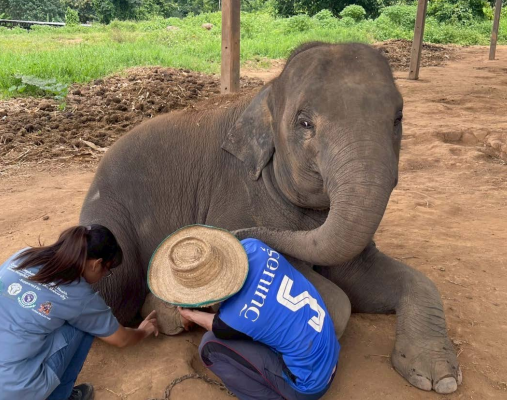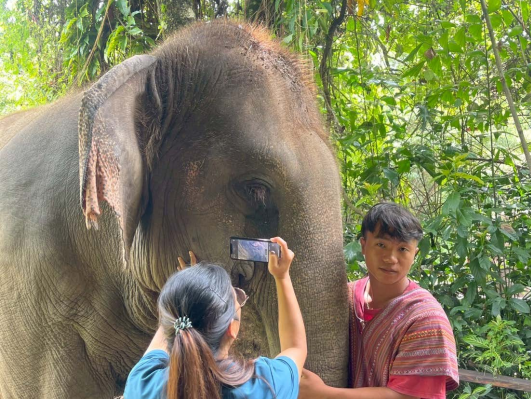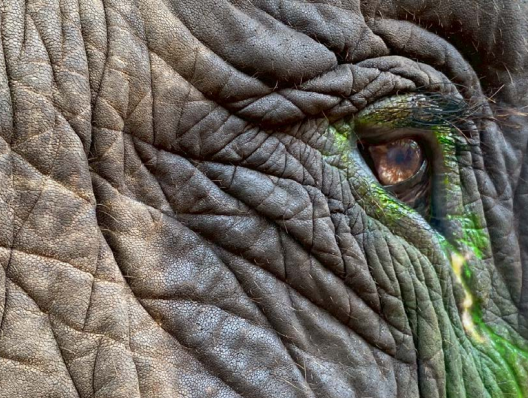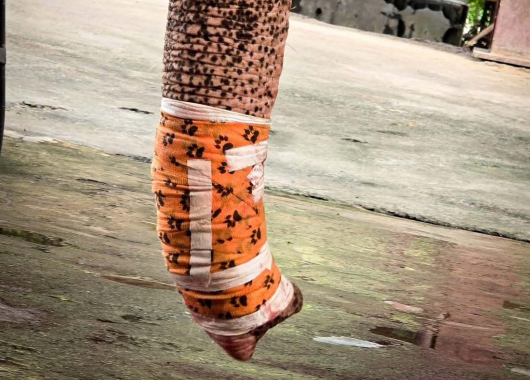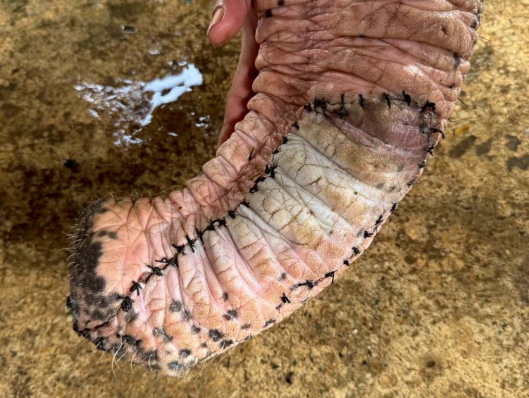This month, the CMU Mobile Veterinary Clinic team treated elephants with various conditions, including colic, chronic wounds, eye ulcers, and foot abscesses. One of the more challenging cases involved suturing an injured trunk, a reminder of how complex and delicate elephant medicine can be. Fortunately, most of their patients responded well to treatment and are now recovering.
Early in the month, an owner called the team to examine a 7-year-old female elephant that had stepped on a nail. The mahout reported that he had immediately removed the nail, which was long, narrow, and covered with rust. Upon examination, they found only a small scratch-like wound on the sole of the left hind foot, and the elephant was still bearing weight normally. The veterinarian attempted to explore the wound but found no open tract. A tetanus toxoid vaccine was administered as a precaution. Unfortunately, about four weeks later, the camp manager contacted the CMU team again to report that the wound had developed into a foot abscess. The elephant was now severely lame, and the abscess had ruptured near the site of the nail injury. She was unable to place her heel on the ground and instead rested her front nail while walking.
Upon re-examination, overgrown granulated tissue was found protruding from the wound and some areas of the foot pad had already been trimmed by the mahout. The elephant showed pain during the procedure, making thorough wound cleaning difficult. The veterinarian carefully trimmed the foot pad and inserted a cotton swab into the tract, which helped release the pressure from a large amount of foul-smelling pus. The elephant’s foot was then soaked in a large tub with povidone-iodine solution, and antibiotic therapy was initiated, along with pain management. Two days later, the mahout reported continued improvement of the injury site due to repeated soaks and treatment.
Vet and mahout search for nail puncture wound near the date of injury
Foot soaking with providone-iodine solution
w
The team had several calls for eye care this month with a couple elephants presenting with corneal ulcers. On September 9, the vets visited an elephant whose mahout reported excessive tearing from the eye for the past three days, with no sign of improvement. However, by the time the team arrived; the lacrimation had already subsided. Upon close examination, the corneal surface appeared slightly irregular, suggesting mild irritation but without the formation of a whitish spot. A fluorescein stain test was performed and showed a negative result, indicating no corneal ulceration. The veterinarian advised the mahout to clean the eye regularly using an eye-rinsing solution only.
In another eye case, the owner of a 30-year-old had sent a photo for preliminary assessment, which showed a closed eye, redness, swollen eyelids, and excessive tearing. From the mahout’s history, the elephant had been showing signs of eye pain and tearing for about a week. He had previously applied an orange-colored eye drop, which upon review was found to be a steroid-based medication. On examination, the right eye showed a corneal ulcer with a whitish spot and positive fluorescein staining, along with excessive tearing and warmth around the eyelid area. Fortunately, the mahout had already been trained in proper eye-washing techniques and demonstrated the procedure very well. The veterinarian explained to the mahout, guide, and owner the importance of avoiding steroidal eye drops in cases of corneal ulceration and pain relief medication was prescribed to support recovery.
Vet grabs a close-up to examine the eye
While working in the Mae Wang area, the vets were also asked to examine a female elephant living nearby that had a chronic eye problem. Upon arrival, they observed excessive tearing from her left eye and a small whitish spot on the cornea. The veterinarian demonstrated proper eye-rinsing and topical medication techniques for the mahout and then supervised him as he practiced the procedure. Eye care supplies and an anti-inflammatory drug were provided for continued home treatment. During a follow-up visit three weeks later, the elephant’s condition had significantly improved. She showed normal tear production, no signs of irritation, and her eye appeared comfortable and healthy.
Long tear length and whitish lesion on cornea
While working at the camp on the above case, the camp’s veterinary assistant noticed something unusual with another elephant nearby. Upon checking, the team and camp vet assistant discovered that she had sustained a severe injury to the end of her trunk, likely caused by the nearby bull resting too close to her. The incident was shocking for everyone at the clinic. Fortunately, the bleeding was minimal. The mahout quickly moved her to the treatment stall for emergency care.
Examination revealed a long, deep laceration at the tip of the trunk, penetrating into the lumen and leaving a skin flap. The team decided to sedate the elephant to allow thorough cleaning and wound repair. After about an hour, the elephant was under sufficient sedation, and her trunk was gently laid on the ground. The wound was cleaned with chlorhexidine scrub, rinsed repeatedly with normal saline, and then disinfected with povidone-iodine solution before suturing. The procedure took nearly two hours, and the team successfully completed the suturing. The wound was covered with a bandage, and the reversal drug was administered afterward. The elephant recovered smoothly from sedation. The camp veterinarian continued post-operative care, including antibiotics and pain management.
Unfortunately, suturing a trunk wound in elephants is extremely challenging due to its constant movement and critical role in daily functions. Despite diligent daily wound care, necrotic tissue was observed on the fourth day post-surgery, and most of the sutures had failed. This case served as a valuable lesson for the CMU team highlighting both the delicate anatomy of the elephant trunk and the limitations of conventional suturing techniques. The team will continue monitoring her recovery and adjust the wound management approach to support natural healing while maintaining her comfort and trunk function.
Post-op day 1 after suturing
The professionals of the Chiang Mai University Mobile Vet Clinic continue to provide top notch care for elephants in all states of health. We are so grateful for their efforts to educate fellow veterinary care providers and mahouts and providing care for Thai elephants of all ages! Donate today to support the care of Thai elephants.

